Oklahoma City, Oklahoma, Hgh State Clinic, Hgh Injections, Hrt Doctors
Oklahoma City, Oklahoma Blood Testing Facilities
 Represents a LabCorp blood testing facility
Represents a LabCorp blood testing facility Represents a Quest Diagnostics blood testing facility
Represents a Quest Diagnostics blood testing facility
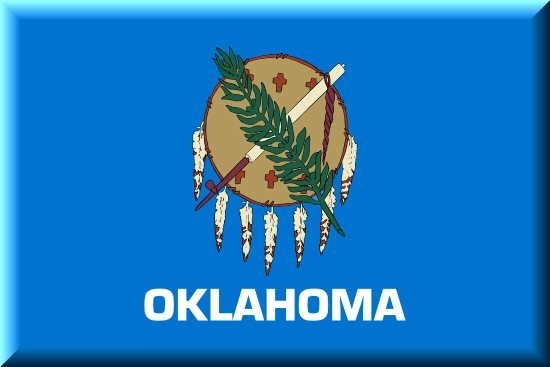
Nearby Labcorp Blood Testing facilities:
- Labcorp Center Distance: 0 m, 1111 N Lee Ste 235, Oklahoma City, Oklahoma County, OK, 73103
- Labcorp Center Distance: 5 m, 5401 N Portland 110, Oklahoma City, Oklahoma County, OK, 73112
- Labcorp Center Distance: 6 m, 8125 S Walker Ste C, Oklahoma City, Oklahoma County, OK, 73139
- Labcorp Center Distance: 8 m, 1201 S Douglas Blvd Ste A, Midwest City, Oklahoma County, OK, 73112
- Labcorp Center Distance: 10 m, 3705 W Memorial Rd Ste 1406, Oklahoma City, Oklahoma County, OK, 73134
- Labcorp Center Distance: 16 m, 1010 24Th Ave Nw Ste 130, Norman, Cleveland County, OK, 73071
- Labcorp Center Distance: 96 m, 533 N Gilcrease Museum Road, Tulsa, Tulsa County, OK, 74127
- Labcorp Center Distance: 98 m, 6717 S. Yale 104, Tulsa, Tulsa County, OK, 74136
- Labcorp Center Distance: 99 m, 3336 E 32Nd Street Ste 104, Tulsa, Tulsa County, OK, 74135
Nearby Quest Blood Testing facilities:
- Quest Center Distance: 3 m, 4221 South Western Avenue, Oklahoma City, Oklahoma County, OK, 73109-3447
- Quest Center Distance: 5 m, 3366 Nw Expressway, Oklahoma City, Oklahoma County, OK, 73112-4444
- Quest Center Distance: 6 m, 8100 S Walker Ave, Oklahoma City, Oklahoma County, OK, 73139-9402
- Quest Center Distance: 8 m, 9060 Harmony Drive, Midwest City, Oklahoma County, OK, 73130-6253
- Quest Center Distance: 10 m, 13901 Mcauley Blvd, Oklahoma City, Oklahoma County, OK, 73134-8700
- Quest Center Distance: 12 m, 4833 Integris Parkway, Edmond, Oklahoma County, OK, 73034-8864
- Quest Center Distance: 13 m, 1607 Professional Cir, Yukon, Canadian County, OK, 73099-6314
- Quest Center Distance: 14 m, 3201 W Tecumseh Rd, Norman, Cleveland County, OK, 73072-1819
- Quest Center Distance: 17 m, 900 N Porter Ave Ste 109, Norman, Cleveland County, OK, 73071-6426
- Quest Center Distance: 33 m, 3700 N Kickapoo Ave, Shawnee, Pottawatomie County, OK, 74804-1707
- Quest Center Distance: 50 m, 819 S Pine St, Stillwater, Payne County, OK, 74074-4350
- Quest Center Distance: 66 m, 915 East Owen K Garriott, Enid, Garfield County, OK, 73701-5952
- Quest Center Distance: 69 m, 701 Better Now Plaza, Ada, Other, OK, 74820-2643
- Quest Center Distance: 70 m, 1509 Brookwood Ave, Duncan, Stephens County, OK, 73533-1315
- Quest Center Distance: 79 m, 4411 W Gore Blvd, Lawton, Comanche County, OK, 73505-5977
- Quest Center Distance: 80 m, 1401 Sw Parkridge Blvd Ste C, Lawton, Comanche County, OK, 73505-7575
- Quest Center Distance: 81 m, 812 W Gary Blvd, Clinton, Custer County, OK, 73601-2720
- Quest Center Distance: 90 m, 400 Fairview Ave, Ponca City, Kay County, OK, 74601-1910
- Quest Center Distance: 92 m, 107 N Commerce St, Ardmore, Carter County, OK, 73401-3904
- Quest Center Distance: 95 m, 607 E Main St, Jenks, Tulsa County, OK, 74037-4138
- Quest Center Distance: 98 m, 1145 S Utica Ave, Tulsa, Tulsa County, OK, 74104-4000
Oklahoma City Hormone Replacement Therapy Services
We here at the Conscious Evolution Institute understand the importance of Hormone Balance, and we are a licensed and board-certified Medical Hormone Clinic which specializes in providing the best Hormone Therapy Products available in the world today, directly to your door. With our help, we can provide you with a full and vivid picture of your Hormone Status, as well as your overall health, giving you the knowledge and care that you deserve to overcome Hormone Deficiency and live a healthier life.
Our clinic serves men and women thirty years and older, and if you are interested in the treatments that we provide, you can fill out the form on this page or call us for an absolutely free consultation. One of our clinical specialists will provide you with detailed information regarding how our treatments work and how you can arrange for an appointment with a local affiliate in the Oklahoma City area to get started!
Oklahoma City Low-T Therapy for Testosterone Deficiency
Testosterone is the keystone of male health, and is important for sustaining sexual, physical, and psychological vitality in men. The big problem with Testosterone is that, beyond a certain age, the older that you get, the less Testosterone that your body produces. Millions of men across America struggle with Testosterone Deficiency and Andropause, and Testosterone Replacement Therapy can help men restore normal Testosterone Levels and feel more like their old selves.
Testosterone Deficiency is characterized by a number of symptoms, including anxiety, lack of confidence, erectile dysfunction, waning sex drive, weight gain, fatigue, loss of physical strength as well as loss of bone mineral density. The Conscious Evolution Institute provides a number of products to help you get your Testosterone Levels back to those levels associated with early adulthood, including Testosterone Injections, Testosterone Dermal Patches, and Testosterone Creams.
Oklahoma City Human Growth Hormone Replacement Therapy for HGH Deficiency
Human Growth Hormone Deficiency is an age-related condition that occurs when the pituitary no longer naturally makes enough of the Hormone to meet the needs of a patient. Healthy HGH production is a vital aspect of maintaining a healthy life and aging gracefully. Growth Hormone Levels start to go into decline around the age of thirty, and as the hormone decline worsens, it becomes more problematic for the patient.
Symptoms of HGH Deficiency include cognitive decline, foggy memory, fatigue, depression, loss of strength, increased body fat, worsening of deep lines and wrinkles, and trouble healing. If you are experiencing symptoms like these, give us a call and ask about Human Growth Hormone Therapy and how we can make you feel and look better than you have in years!
Oklahoma City Sermorelin Injections for HGH Deficiency
HGH Deficiency is a serious medical condition, but Growth Hormone Injections are not the only option available for patients. Sermorelin Acetate is a Recombinant Hormone Treatment that has the ability to naturally boost the body's ability to produce its own, real Human Growth Hormone. Sermorelin perfectly simulates the function of Growth Hormone-Releasing Hormone, or GH-RH, in the brain, allowing the body to successfully and precisely meet its own needs. Sermorelin Acetate is a fantastic choice for patients, because it is less expensive for patients, and provides heightened benefits in comparison to Bio-Identical HGH. Fill out the form on this page to find out more!
Oklahoma City HCG Weight Loss Diet
Our Hormone Doctors also specialize in treatments designed to facilitate healthy physical transition, allowing you to reach a more ideal physiological state. The HCG Diet is one of the tools at our doctors' disposal, and it can help you overcome obesity and reach a healthier and more beautiful body composition. HCG, when combined with caloric restriction, optimizes your metabolism and helps you lose weight quickly, at a rate of as much as a pound per day. This amazing Hormone Therapy makes it easier to diet by suppressing hunger and increasing the efficiency with which the body burns fat calories. With Injectable HCG, dieting is easier than ever before!
Oklahoma City, Oklahoma Information
Oklahoma City is the most populous city in the State of Oklahoma, and it is also the capital of the state. Oklahoma City goes by a variety of nicknames, including The Big Friendly and OKC. The city was first settled by Americans in 1889, when the United States opened up the territory, offering land to men and families willing to settle in the area. Oklahoma City experienced a big population and economic boom as a result of the vast oil reserves located in and around the city. Oklahoma City is actually the second capital of Oklahoma, as the original capital of the state was Guthrie, Oklahoma.
Oklahoma City has a number of sports franchises located in the city, including the Oklahoma City Barons and the Redhawks, but the city only has one major professional sports team—The Oklahoma City Thunder, a franchise which was moved to Oklahoma City from Seattle, when it was known as the Seattle Supersonics.
Oklahoma City is a center for education in the state of Oklahoma, and as such, there are a number of colleges and universities located in the city, including Rose State College and Oklahoma City University. The economy of Oklahoma City is driven largely by the production of energy, and there are many energy companies located in Oklahoma City, including McKesson Corporation, Devon Energy Corporation, and Chesapeake Energy Corporation. The popular drive-in restaurant, Sonic, is also based out of Oklahoma City. Aside from energy production, Oklahoma City has a strong economy owing also to its importance in regional government and healthcare.
As a center of government and commerce, Oklahoma City has many landmarks and cultural attractions for the enjoyment of its citizens and visitors to the city. Things to see and do in Oklahoma City include the Oklahoma City Philharmonic, the Oklahoma City Museum of Art, the Museum of Osteology, and the American Banjo Museum. The city also has many great entertainment venues, including the Poteet Theater, the Kirkpatrick Auditorium, and the Lyric Theater.
All About Oklahoma City, Oklahoma Geographic Area
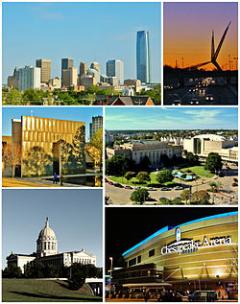

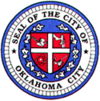
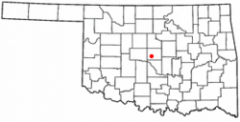
Oklahoma City (Pawnee: Uukuhuuwasiri) is the capital and the largest city in the U.S. state of Oklahoma. The county seat of Oklahoma County, the city ranks 30th among United States cities in population. The city's population, from the 2010 census, was 579,999, with a metro-area population of 1,252,987. In 2010, the Oklahoma City-Shawnee Combined Statistical Area had a population of 1,322,249 residents. Oklahoma City's city limits extend into Canadian, Cleveland, and Pottawatomie counties, though much of those areas outside of the core Oklahoma County area are suburban or rural (watershed). The city ranks as the eighth-largest city in the United States by land area (including consolidated city-counties; it is the second-largest city in the United States by land area whose government is not consolidated with that of a county).
Oklahoma City features one of the largest livestock markets in the world. Oil, natural gas, petroleum products and related industries are the largest sector of the local economy. The city is situated in the middle of an active oil field and oil derricks dot the capitol grounds. The federal government employs large numbers of workers at Tinker Air Force Base and the United States Department of Transportation's Mike Monroney Aeronautical Center. (These two sites house several offices of the Federal Aviation Administration and the Transportation Department's Enterprise Service Center, respectively.)
The city was founded during the Land Run of 1889, and grew to a population of over 10,000 within hours of its founding. The city was the scene of the April 19, 1995 bombing attack of the Alfred P. Murrah Federal Building, in which 168 people died. It was the worst terror attack in the history of the United States before the attacks of September 11, 2001, and remains the worst act of domestic terrorism in U.S. history.
Oklahoma City lies along one of the primary travel corridors into Texas and Mexico, and is about three hours by highway to the Dallas-Fort Worth metropolitan area. Located in the Frontier Country region of the state, the city's northeast section lies in an ecological region known as the Cross Timbers. Since the time weather records have been kept, Oklahoma City has been struck by nine strong tornadoes, eight (E)-F4's and one F5. On May 3, 1999 parts of southern Oklahoma City and nearby communities suffered one of the most powerful tornadoes on record.
Oklahoma City was settled on April 23, 1889, when the area known as the "unassigned lands" was opened for settlement in an event known as "The Land Run". Some 10,000 homesteaders settled the area that would become the capital of Oklahoma. The town grew quickly; the population doubled between 1890 and 1900. Early leaders of the development of the city included Anton Classen, John Shartel, Henry Overholser and James W. Maney.
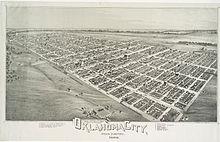
By the time Oklahoma was admitted to the Union in 1907, Oklahoma City had surpassed Guthrie, the territorial capital, as the population center and commercial hub of the new state. Soon after, the capital was moved from Guthrie to Oklahoma City. Oklahoma City was a major stop on Route 66 during the early part of the 20th century; it was prominently mentioned in Bobby Troup's 1946 jazz classic, "(Get Your Kicks on) Route 66", later made famous by Nat King Cole.
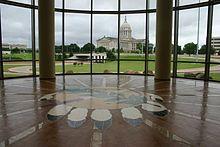
Before World War II, Oklahoma City developed major stockyards, attracting jobs and revenue formerly in Chicago and Omaha. With the 1928 discovery of oil within the city limits (including under the State Capitol), it became a center of oil production. Post-war growth accompanied the construction of the Interstate Highway System, which made Oklahoma City a major interchange as the convergence of I-35, I-40 and I-44. It was also aided by federal development of Tinker Air Force Base.
As with many other American cities, center city population declined in the 1970s and 80s as families followed newly constructed highways to move to newer housing in nearby suburbs. Urban renewal projects in the 1970s, including the Pei Plan, removed many older historic structures but failed to spark much new development, leaving the city dotted with vacant lots used for parking. A notable exception was the city's construction of the Myriad Gardens and Crystal Bridge, a botanical garden and modernistic conservatory in the heart of downtown. Architecturally significant historic buildings lost to clearances were the Criterion Theater, the Baum Building, the Hales Building, and the Biltmore Hotel.
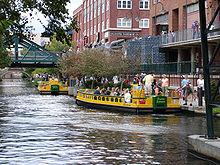
In 1993, the city passed a massive redevelopment package known as the Metropolitan Area Projects (MAPS), intended to rebuild the city's core with civic projects to establish more activities and life to downtown. The city added a new baseball park; central library; renovations to the civic center, convention center and fairgrounds; and a water canal in the Bricktown entertainment district. Water taxis transport passengers within the district, adding color and activity along the canal. MAPS has become one of the most successful public-private partnerships undertaken in the U.S., exceeding $3 billion in investments. As a result of MAPS, the population living in downtown housing has greatly increased, together with demand for residential amenities, such as grocery, services and other retail stores.
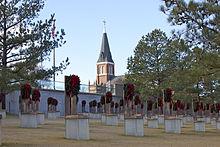
Since the MAPS projects' completion, the downtown area has seen continued development. Several downtown buildings are undergoing renovation/restoration. Notable among these was the restoration of the Skirvin Hotel in 2007. The famed First National Center is being renovated.
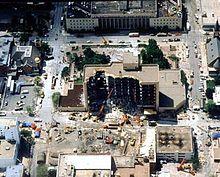
Residents of Oklahoma City suffered substantial losses on April 19, 1995 when Timothy McVeigh set off a bomb in front of the Murrah building. The building was destroyed, more than 100 nearby buildings suffered severe damage, and 168 people were killed. The site has been commemorated as the Oklahoma City National Memorial and Museum. Since its opening in 2000, over 3 million people have visited. Every year on April 19, survivors, families and friends return to the memorial to read the names of each person lost.
The "Core-to-Shore" project was created to relocate I-40 one mile (1.6 km) south and replace it with a boulevard to create a landscaped entrance to the city. This also allows the central portion of the city to expand south and connect with the shore of the Oklahoma River. Several elements of "Core to Shore" were included in the MAPS 3 proposal approved by voters in late 2009.
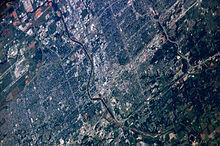
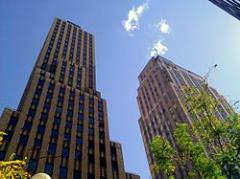
Oklahoma City lies along one of the primary corridors into Texas and Mexico, and is a three-hour drive from the Dallas-Fort Worth metropolitan area. The city is located in the Frontier Country region in the center of the state, making it an ideal location for state government.
According to the United States Census Bureau, the city has a total area of 621.2 square miles (1,609 km2), of which, 607.0 square miles (1,572 km2) of it is land and 14.2 square miles (37 km2) of it is water. The total area is 2.28 percent water.
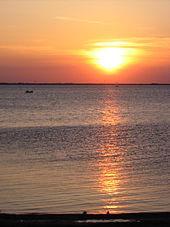
Oklahoma City lies in the Sandstone Hills region of Oklahoma, known for hills of 250 to 400 feet (120 m) and two species of oak: blackjack oak (Quercus marilandica) and post oak (Q. stellata). The northeastern part of the city and its suburbs fall into an ecological region known as the Cross Timbers.
The city is roughly bisected by the North Canadian River (recently renamed the Oklahoma River inside city limits). The North Canadian once had sufficient flow to flood every year, wreaking destruction on surrounding areas, including the original Oklahoma City Zoo. In the 1940s a dam was built on the river to manage the flood control and reduced its level. In the 1990s, as part of the citywide revitalization project known as MAPS, the city built a series of low-water dams, returning water to the portion of the river flowing near downtown. The city has three large lakes: Lake Hefner and Lake Overholser, in the northwestern quarter of the city; and the largest, Lake Stanley Draper, in the sparsely populated far southeast of the city.
The population density normally reported for Oklahoma City using the area of its city limits can be a bit misleading. Its urbanized zone covers roughly 244 sq mi (630 km2), compared with larger rural areas incorporated by the city, which cover the remaining 377 sq mi (980 km2) of the city limits.
Oklahoma City is one of the largest cities in the nation in compliance with the Clean Air Act.
Oklahoma City has a humid subtropical climate, with frequent variations in weather daily and seasonally, except during the consistently hot and humid summer months. Consistent winds, usually from the south or south-southeast during the summer, help temper the hotter weather. Consistent northerly winds during the winter can intensify cold periods.
The average temperature is 60.2 °F (15.7 °C), though colder through the winter months, with a 36.7 °F (2.6 °C) average in January, and warmer during the summer months, with an 82 °F (27.8 °C) average in July. Extremes range from na17 °F ( na27 °C) on February 12, 1899 to 113 °F (45 °C) on August 11, 1936 and August 3, 2012. The city receives about 35.9 inches (912 mm) of precipitation annually and 8.6 inches (21.8 cm) of snow.
Oklahoma City has a severe weather season from March through August, especially during April and May. Tornadoes have occurred in every month of the year. Oklahoma City has become one of the most tornado prone cities in the United States. Since the time weather records have been kept, Oklahoma City has been struck by nine violent tornadoes, eight F4's and one F5. On May 3, 1999 parts of southern Oklahoma City and nearby communities suffered one of the most powerful tornadoes on record, an F-5 on the Fujita Scale, with wind speeds topping 318 mph (510 km/h). This tornado was part of the 1999 Oklahoma tornado outbreak.
Oklahoma City neighborhoods vary as much as Oklahoma's climate. Historic, renovated neighborhoods are next to others that suffered from a mix of economic and social factors, such as the loss of jobs and move of the middle and upper classes to the suburbs.
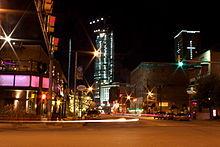
Some are still struggling. Inner-city neighborhoods radiate from those located in downtown and include mostly single-family detached houses with small yards and the occasional apartment complex. In the downtown and northwest business area, there are numerous condo and loft developments and several mid-rise and high-rise options.
Downtown Oklahoma City is currently undergoing a renaissance, one of the largest in the nation. Middle-class moves during the 1950s and 1960s left much of the inner city abandoned, and retail services declined. During the urban renewal of the early 1980s, almost 50 historic buildings and skyscrapers were demolished as part of the overall plan. Examples include the Biltmore Hotel, which made way for the I. M. Pei-designed Myriad Botanical Gardens, but this was at least a major urban renewal project completed as planned. Others were not, leaving vacant lots where buildings had stood. Many of the historic buildings remaining in the Central Business District were covered by new facades or adapted as Class-C office space. The removal of historic structures, which followed the decrease in population, left downtown without many retail options.
According to the 2010 U.S. Census, the racial composition of Oklahoma City was as follows:
Source:
As of the 2010 census, there were 579,999 people, 230,233 households, and 144,120 families residing in the city. The population density was 956.4 inhabitants per square mile (321.9/km ²). There were 256,930 housing units at an average density of 375.9 per square mile (145.1/km ²).
There were 230,233 households, 29.4% of which had children under the age of 18 living with them, 43.4% were married couples living together, 13.9% had a female householder with no husband present, and 37.4% were non-families. One person households account for 30.5% of all households and 8.7% of all households had someone living alone who is 65 years of age or older. The average household size was 2.47 and the average family size was 3.11.
The median income for a household in the city was $43,798, and the median income for a family was $54,721. The per capita income for the city was $25,042. 16.6% of the population and 12.4% of families were below the poverty line. Out of the total population, 23.0% of those under the age of 18 and 9.2% of those 65 and older were living below the poverty line.
In the 2000 Census Oklahoma City's age composition was 25.5% under the age of 18, 10.7% from 18 to 24, 30.8% from 25 to 44, 21.5% from 45 to 64, and 11.5% who were 65 years of age or older. The median age was 34 years. For every 100 females there were 95.6 males. For every 100 females age 18 and over, there were 92.7 males.
In June, 2007, the U.S. Census announced its estimate population of 547,274 and that Oklahoma City had grown 1.4 percent between July, 2006 and July, 2007. Since the official Census in 2000, Oklahoma City had grown 8.1 percent, according to the Census Bureau's estimates.
Oklahoma City is the principal city of the eight-county Oklahoma City Metropolitan Statistical Area in Central Oklahoma and is the state's largest urbanized area. Based on population rank, the metropolitan area was the 44th largest in the nation as of the year 2010.
Powdered cocaine and crack cocaine are widely available in Oklahoma City. Street gangs such as the Bloods, Crips, South Side Locos, GBC (Grand Barrio Central) and Juaritos have become active in the city and are the primary retail distributors of crack cocaine. Cocaine abuse is prevalent among adult male arrestees in Oklahoma City. According to data from the Arrestee Drug Abuse Monitoring system ("ADAM"), almost one-quarter (22.4%) of adult male arrestees in Oklahoma City tested positive for cocaine in 2000.
The South Side Locos are still considered one of the city's most violent gangs. Oklahoma City Police estimate that on any given night, as many as 6,000 gang members may be out on Oklahoma City streets.
With regards to Mexican drug cartels, Oklahoma City has traditionally been the territory of the notorious Juarez Cartel, but the Sinaloa Cartel has been reported as trying to establish a foothold in Oklahoma City.
Oklahoma City also has its share of very brutal crimes, particularly in the 1970s. The worst of which occurred in 1978, when six employees of a Sirloin Stockade restaurant on the city's south side were murdered execution-style in the restaurant's freezer. An intensive investigation followed, and the three individuals involved, who also killed three others in Purcell, Oklahoma, were identified. One, Harold Stafford, died in a motorcycle accident in Tulsa not long after the restaurant murders. Another, Verna Stafford, was sentenced to life without parole after being granted a new trial after she had previously been sentenced to death. Roger Dale Stafford, considered the mastermind of the murder spree, was executed by lethal injection at the Oklahoma State Penitentiary in 1995.
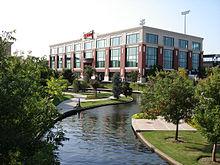
The economy of Oklahoma City, once a regional power center of government and energy exploration, has diversified to include the sectors of information technology, services, health services and administration. The city has two Fortune 500 companies: Devon Energy Corporation and Chesapeake Energy Corporation, several others that are in the Fortune 1000 and a number of large privately owned companies. Oklahoma City is home to the corporate headquarters of Sonic Drive-In, whose office building and corporate restaurant is located in Bricktown. Devon Energy revealed plans in August 2008 for a new 850-foot (260 m) tall, 1,900,000-square-foot (180,000 m2) headquarters building in downtown Oklahoma City. The new skyscraper is currently under construction and is expected to be complete in 2012 and open in 2013.Continental Resources will move more than 250 employees from Enid to its new headquarters in downtown Oklahoma City in 2012.
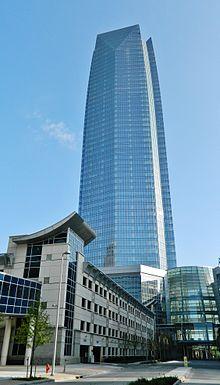
Other large employers in Oklahoma City include McKesson Corp, Tinker Air Force Base, the federal government, the University of Oklahoma, the University of Central Oklahoma, American Fidelity, AT&T, AAA, Bank of America, Bank of Oklahoma, The Boeing Company, Braum's, Dell, The Hertz Corporation, Farmer's Insurance, Integris Health, The Hartford, JP Morgan Chase, Mercy Heath System, Sprint/Nextel, St. Anthony Health System, Williams-Sonoma, Xerox, United Parcel Service, Cox, and the state of Oklahoma. Six Flags at one point was headquartered in Oklahoma City but relocated to New York City on January 27, 2006.
According to the Oklahoma City Chamber of Commerce, the metropolitan area's economic output grew by 33 percent between 2001 and 2005 due chiefly to economic diversification. Its gross metropolitan product was $43.1 billion in 2005 and grew to $61.1 billion in 2009.
In 2008, Forbes magazine named Oklahoma City the most "recession proof city in America". The magazine reported that the city had falling unemployment, one of the strongest housing markets in the country and solid growth in energy, agriculture and manufacturing. However, during the 1980s, Oklahoma City had one of the worst job and housing markets due to the bankruptcy of Penn Square Bank in 1982 and then the post-1985 crash in oil prices.
Business Districts, and to a lesser extent, neighborhoods tend to maintain their boundaries and character through the application of zoning regulations and Business Improvement Districts (districts where property owners agree to a property tax surcharge to support additional services for the community). Through zoning regulations, historic districts, and other special zoning districts, including overlay districts, are established. Oklahoma City currently has three Business Improvement Districts, including Downtown Oklahoma City.
The Donald W. Reynolds Visual Arts Center is the new downtown home for the Oklahoma City Museum of Art. The museum features visiting exhibits, original selections from its own collection, a theater showing a variety of foreign, independent, and classic films each week, and a restaurant. OKCMOA is also home to the most comprehensive collection of Chihuly glass in the world including the fifty-five foot Eleanor Blake Kirkpatrick Memorial Tower in the Museum's atrium. The newly renovated art deco Civic Center Music Hall has performances from Oklahoma City Ballet and opera to traveling Broadway shows and concerts. Stage Center for the Performing Arts is home to many of the city's top theater companies. The building that houses Stage Center, originally called the Mummers Theater and designed by John M. Johansen, is a modernist architectural landmark, with the original model displayed in MOMA in New York City.
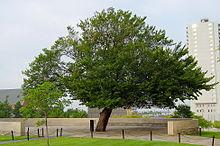
Other theaters include the Lyric Theatre, Jewel Box Theatre, the Kirkpatrick Auditorium, the Poteet Theatre and the 488-seat Petree Recital Hall, at the Oklahoma City University campus. The university also opened the Wanda L Bass School of Music and auditorium in April 2006.
The Science Museum Oklahoma (formerly Kirkpatrick Science and Air Space Museum at Omniplex) houses exhibits on science, aviation, and an IMAX theater. The museum houses the International Photography Hall of Fame (IPHF) that exhibits photographs and artifacts from a large collection of cameras and other artifacts preserving the history of photography. IPHF honors those who have made significant contributions to the art and/or science of photography.
The Museum of Osteology houses more than three hundred real animal skeletons. The Museum is a unique educational experience. Focusing on the form and function of the skeletal system, this 7,000 sq ft (650 m2). museum displays hundreds of skulls and skeletons from all corners of the world. Exhibits include adaptation, locomotion, classification and diversity of the vertebrate kingdom. The Museum of Osteology is the only one of its kind in America!
The National Cowboy & Western Heritage Museum has galleries of western art and is home to the Hall of Great Western Performers. In contrast, the city will also be home to The American Indian Cultural Center and Museum that began construction in 2009, on the South side of Interstate 40, Southeast from Bricktown.
The Oklahoma City National Memorial in the northern part of Oklahoma City's downtown was created and the inscription on its eastern gate says, "to honor the victims, survivors, rescuers, and all who were changed forever on April 19, 1995". The outdoor Symbolic Memorial can be visited 24 hours a day for free, and the adjacent Memorial Museum, located in the former Journal Record building damaged by the bombing, can be entered for a small fee. The site is also home to the National Memorial Institute for the Prevention of Terrorism, a non partisan, non profit thinktank devoted to the prevention of terrorism.
The American Banjo Museum located in the Bricktown Entertainment district is dedicated to preserving and promoting the music and heritage of America's native musical instrument ae the banjo. With a collection valued at $3.5 million it is truly a national treasure. An interpretive exhibits tells the evolution of the banjo from its humble roots in American slavery, to bluegrass, to folk and world music.
The Oklahoma History Center is the history museum of the State of Oklahoma. Located across the street from the Governor's mansion at 800 Nazih Zuhdi Drive in Oklahoma City, the museum opened in 2005 and is operated by the Oklahoma Historical Society. It preserves the history of Oklahoma from the prehistoric to the present day.
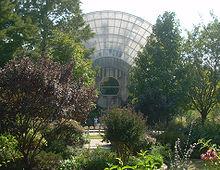
One of the more prominent landmarks downtown is the Crystal Bridge at the Myriad Botanical Gardens, a large downtown urban park. Designed by I. M. Pei, the Crystal Bridge is a tropical conservatory in the area. The park has an amphitheater, known as the Water Stage. In 2007, following a renovation of the stage, Oklahoma Shakespeare in the Park relocated to the Myriad Gardens. The Myriad Gardens will undergo a massive renovation in conjunction with construction of the Devon Tower directly north of it.
The Oklahoma City Zoo and Botanical Garden is home to numerous natural habitats, WPA era architecture and landscaping, and hosts major touring concerts during the summer at its amphitheater. Oklahoma City also has two amusement parks, Frontier City theme park and White Water Bay water park. Frontier City is an 'Old West' themed amusement park. The park also features a recreation of a western gunfight at the 'OK Corral' and many shops that line the "Western" town's main street. Frontier City also hosts a national concert circuit at its amphitheater during the summer.
Walking trails line Lake Hefner and Lake Overholser in the northwest part of the city and downtown at the canal and the Oklahoma River. The majority of the east shore area is taken up by parks and trails, including a new leashless dog park and the postwar-era Stars and Stripes Park. Lake Stanley Draper is the city's largest and most remote lake.
Oklahoma City has a major park in each quadrant of the city, going back to the first parks masterplan. Will Rogers Park, Lincoln Park, Trosper Park, and Woodson Park were once connected by the Grand Boulevard loop, some sections of which no longer exist. Martin Park Nature Center is a natural habitat in far northwest Oklahoma City. Will Rogers Park is home to the Lycan Conservatory, the Rose Garden, and Butterfly Garden, all built in the WPA era. Oklahoma City is home to the American Banjo Museum, which houses a large collection of highly decorated banjos from the early 20th century and exhibits on the history of the banjo and its place in American History. Concerts and lectures are also held there.
In April, 2005 the Oklahoma City Skate Park at Wiley Post Park was renamed the Mat Hoffman Action Sports Park to recognize Mat Hoffman, an Oklahoma City Metropolitan Area resident and businessman that was instrumental in the design of the skate park and is a 10-time BMX World Vert champion. In March, 2009, the Mat Hoffman Action Sports Park was named by National Geographic Society Travel Guide as one of the "Ten Best."
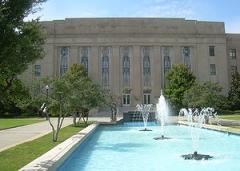
The City of Oklahoma City has operated under a council-manager form of city government since 1927. Mick Cornett serves as Mayor, having first been elected in 2004, re-elected in 2006 and then again in 2010. Eight councilpersons represent each of the eight wards of Oklahoma City. City Manager Jim Couch was appointed in late 2000. Couch previously served as assistant city manager, Metropolitan Area Projects director and utilities director prior to his service as city manager.
The city has called on residents to vote for sales tax-based projects to revitalize parts of the city. The Bricktown district is the best example of such a project. In the recent MAPS 3 vote, the city's fraternal order of police criticized the project proposals for not doing enough to expand the police presence to keep up with increased commercial activity.
Most neighborhoods in Oklahoma City lean Republican, but there are a few exceptions. The northeast portion of Oklahoma City and certain neighborhoods in the northwest are generally represented by Democratic state legislators. The Oklahoma City Council is non-partisan.
The city is home to several colleges and universities.
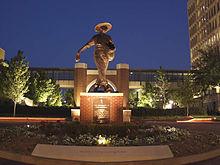
Oklahoma City University, formerly known as Epworth University, was founded by the United Methodist Church on September 1, 1904 and is renowned for its performing arts, medical services, mass communications, business, law, and athletic programs.
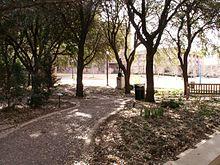
The University of Oklahoma has institutions of higher learning in the city and metropolitan area, with OU Medicine and The University of Oklahoma Health Sciences Center campuses east of downtown in the Oklahoma Health Center and the main University of Oklahoma campus located in the suburb of Norman. The University of Oklahoma Health Sciences Center is one of the nation's largest independent medical centers, employing more than 12,000 people. OU is one of only four major universities in the nation to have all six medical schools.[clarification needed] The third-largest university in the state, the University of Central Oklahoma, is located just north of the city in the suburb of Edmond, as is Oklahoma Christian University, one of the state's private liberal arts institutions.
Oklahoma City Community College in south Oklahoma City is the second-largest community college in the state.Rose State College is located east of Oklahoma City in suburban Midwest City. Oklahoma State University - Oklahoma City is located in the "Furniture District" on the Westside. Northeast of the city is Langston University, the state's historically black college (HBCU). Langston also has an urban campus in the eastside section of the city. Southern Nazarene University, which was founded by the Church of the Nazarene, is a university located in suburban Bethany, which is surrounded by Oklahoma City.
Although technically not a university, the FAA aos Mike Monroney Aeronautical Center has many aspects of an institution of higher learning. Its FAA Academy is accredited by the North Central Association of Colleges and Schools. Its Civil Aerospace Medical Institute (CAMI) has a medical education division responsible for aeromedical education in general as well as the education of aviation medical examiners in the US and 93 other countries. In addition, The National Academy of Science offers Research Associateship Programs for fellowship and other grants for CAMI research.
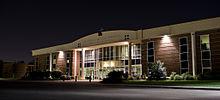
Oklahoma City is home to the state's largest school district, Oklahoma City Public Schools. The district's Classen School of Advanced Studies and Harding Charter Preparatory High School rank high among public schools nationally according to a formula that looks at the number of Advanced Placement, International Baccalaureate and/or Cambridge tests taken by the school's students divided by the number of graduating seniors. In addition, Belle Isle Enterprise Middle School in OKCPS was named the top middle school in the state according to the Academic Performance Index, and recently received the Blue Ribbon School Award, in 2004 and again in 2011.
The Oklahoma School of Science and Mathematics, a school for some of the state's most gifted math and science pupils, is also located in Oklahoma City.
Numerous suburban school districts surround the urban Oklahoma City Public Schools district, including Putnam City Public Schools in the northwest, Moore Public Schools in the south, and Mid-Del Schools in the southeast. The city boasts a number of private and parochial schools. Casady School and Heritage Hall School are both examples of a private college preparatory school with vigorous academics that range among the top in Oklahoma. Providence Hall is a Protestant school. Two prominent schools of the Archdiocese of Oklahoma City are Bishop McGuinness High School and Mount Saint Mary High School.
Oklahoma City has several public career and technology education schools associated with the Oklahoma Department of Career and Technology Education, the largest of which are Metro Technology Center and Francis Tuttle Technology Center.
Private career and technology education schools in Oklahoma City include Oklahoma Technology Institute, Platt College, Vatterott College, and Heritage College.
A nonprofit vocational training center for individuals with disabilities in Oklahoma City is Dale Rogers Training Center.
The Oklahoman is Oklahoma City's major metro newspaper and is the most widely circulated in the state. Oklahoma Gazette is Oklahoma City's independent newsweekly, featuring such staples as local commentary, feature stories, restaurant reviews and movie listings and music and entertainment. The Journal Record is Oklahoma City's daily business newspaper and okcBIZ is a monthly publication that covers business news affecting those who live and work in Central Oklahoma.
There are various community and international papers in the city that cater to the ethnic mosaic of the city; such as The Black Chronicle, headquartered in the Eastside, the OK VIETIMES and Oklahoma Chinese Times, located in Asia District, and various Hispanic publications. The Campus is the student newspaper at Oklahoma City University. Gay publications include Gossip Boy, which despite its name has become known for adventurous undercover work and investigative journalism that has attracted a national audience, and The Gayly Oklahoman.
An upscale lifestyle publication called Slice Magazine is produced by local publisher Southwestern Publishing and circulated throughout the metro. In addition is a magazine published by Back40 Design Group called The Edmond Outlook. It contains local commentary and human interest pieces direct-mailed to over 50,000 Edmond residents.
Oklahoma City was home to several pioneers in radio and television broadcasting. Oklahoma City's WKY Radio was the first radio station transmitting west of the Mississippi River and the third radio station in the United States. WKY received its federal license in 1921 and has continually broadcast under the same call letters since 1922. In 1928, WKY was purchased by E.K. Gaylord's Oklahoma Publishing Company and affiliated with NBC; in 1949, WKY-TV went on the air and became the first independently-owned television station in the U.S. to broadcast in color. In mid-2002, WKY was purchased outright from the Gaylord family by Citadel Communications who owns and operates it to this day.
All the major U.S. broadcast television networks have affiliates in the Oklahoma City market (ranked 44th for television by Nielsen and 48th for radio by Arbitron, and serves a 34-county area covering the central, northern and west-central Oklahoma), including KFOR 4 (NBC), KOCO 5 (ABC), KWTV 9 (CBS), KETA 13 (PBS; flagship of the state-run OETA member network), KOKH 25 (Fox), KOCB 34 (CW) and KAUT 43 (MNTV); despite the market's geographical size, none of the English-language commercial stations in the Oklahoma City DMA operate full-power satellite stations in the northwest part of the state (requiring cable or satellite to view them), though KFOR-TV operates two low-power translators in that portion of the market. Oklahoma City is one of the few markets located east of Amarillo, north of Dallas and west of Chicago to have affiliates of two or more of the major Spanish-language broadcast networks: KTUZ 30 (Telemundo), Woodward-based KUOK 35 (Univision, its translators KUOK-CD 36 and KUOK-LP 48 serve the immediate Oklahoma City area) and KOHC-CD 45 (Azteca America).
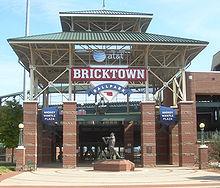
On July 3, 2008 the city of Seattle settled with the owners of the NBA Seattle SuperSonics franchise, allowing them to move the team to Oklahoma City for the 2008 ae2009 season. The relocated team was named the Oklahoma City Thunder on September 3, 2008. The move gave the city its second 'permanent' major professional sports team after the AFL Oklahoma Wranglers. The Oklahoma City Thunder is the third major team overall, considering the temporary hosting of the NBA New Orleans/Oklahoma City Hornets from 2005 ae2007.
Oklahoma City is home to several other professional sports clubs including the Oklahoma City RedHawks, a Triple-A affiliate of the Houston Astros. Other teams include the Oklahoma City Barons of the American Hockey League, which plays at Cox Convention Center.
Chesapeake Energy Arena in downtown is the large multipurpose arena which hosts concerts, NHL exhibition games, and many of the city's pro sports teams. In the 2008 the NBA's Oklahoma City Thunder became the major tenants. Located nearby in Bricktown, the Chickasaw Bricktown Ballpark is the home to the city's baseball team. The Brick, as it is locally known, is considered one of the finest minor league parks in the nation.
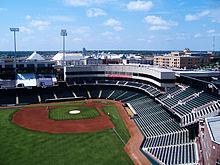
There are several other stadiums and arenas in the city, including the arena inside the Cox Convention Center, the State Fair Arena, Taft Stadium, the Don E. Porter Hall of Fame Stadium, and Abe Lemons Arena which is located at Oklahoma City University.
Oklahoma City is host to numerous major college and amateur sporting events. The major universities in the area ae (University of Oklahoma, Oklahoma City University, and Oklahoma State University) ae often schedule major basketball games and other sporting events at Chesapeake Energy Arena, although most games are played in their campus arenas.
The Oklahoma City University Stars[dead link] has a slate of sporting clubs which play on campus including a top-rated rowing program which has events on the Oklahoma River. Of special note, the university had announced its desire to possibly enter the NCAA during the 2007 athletic season.
Oklahoma City is the annual host of the Big 12 Baseball Tournament, the World Cup of Softball, and the annual NCAA Women's College World Series. The city has held the 2005 NCAA Men's Basketball First and Second round and hosted the Big 12 Men's and Women's Basketball Tournaments in 2007; the city will be the site again in 2009. Since 2006, Oklahoma City has been home to the annual Bricktown Showdown Triple-A Baseball Championship game.
Other major sporting events include Thoroughbred and Quarter horse racing circuits at Remington Park and numerous horse shows and equine events that take place at the state fairgrounds each year. There are numerous golf courses and country clubs spread around the city in addition to tennis clubs and high school level sporting activities including the well known "Polo Bowl" between Casady School (Cyclones) and Heritage Hall School (Chargers).
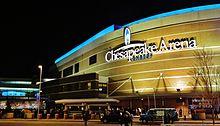
In the aftermath of Hurricane Katrina in New Orleans, Louisiana, and surrounding area, the New Orleans Hornets of the National Basketball Association temporarily relocated to the Ford Center, playing the majority of its home games there during the 2005 ae06 and 2006 ae07 seasons. The team became the first NBA franchise to play regular-season games in the state of Oklahoma.
The team was known as the New Orleans/Oklahoma City Hornets and had adopted a split personality of sorts, wearing 'OKC neutral' home jerseys (with an OKC patch of sorts over an H-alternate jersey) and 'New Orleans' jerseys during away games.
Although some city officials wanted the Hornets to stay in Oklahoma City permanently, the team ultimately returned to New Orleans full-time for the 2007 ae2008 season. The Hornets played their final home game in Oklahoma City during the exhibition season on October 9, 2007 against the Houston Rockets, as a way to say thanks for the temporary hosting. The 'hometown Hornets' won the game 94 ae92.
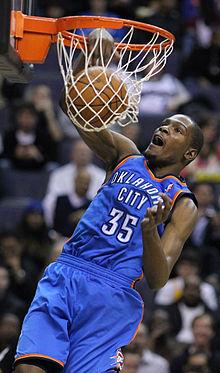
On July 2, 2008, upon settlement of a lawsuit with the city of Seattle, the Seattle SuperSonics announced they would relocate to Oklahoma City on July 3, and begin play at Oklahoma City's Ford Center in the 2008 ae2009 NBA season. The team left the franchise history and team name and colors in Seattle. The team became the fourth NBA franchise to relocate since 1985; the Kansas City Kings moved to Sacramento, the Vancouver Grizzlies to Memphis and the Charlotte Hornets to New Orleans. The new name and color scheme for the Oklahoma City Thunder was announced on September 3; other finalists included Energy, Wind, Marshalls, Barons and Bison.
On April 18, 2008, the NBA gave conditional approval for the Seattle SuperSonics franchise to move to Oklahoma City for the 2008 ae2009 season provided the ownership could free themselves from the legal challenges that existed with the City of Seattle with a 28 ae2 vote by its board of owners.
On July 2, 2008 the City of Seattle reached an agreement to terminate the Sonics' lease and allow the team to relocate to Oklahoma City. Clay Bennett determined that as of July 3, 2008 the relocation of the now defunct Seattle SuperSonics would commence. In April 2010 the Thunder secured a position in the NBA's Western Conference Playoffs, having their best season since the mid 90's and winning two games in a series against the defending champion Lakers. According to Forbes, the first year the team was in Oklahoma City, the Thunder earned $111,000,000 in revenue. This is considered to be an overwhelming success and ranks them in the 20th position in the NBA. The team's operating income of $12.7 million was on par with such old standards of the NBA such as the Boston Celtics who earned $12.9 million and far exceeding the net operating losses of the Dallas Mavericks and the Portland Trailblazers of -$17.4 and -$20.3 respectively.
Oklahoma City was home to the following defunct sports teams:
The city was also the temporary home of the NBA's New Orleans Hornets (known then as the "New Orleans/Oklahoma City Hornets") in the aftermath of Hurricane Katrina.
NCAA Division II in 2012
GAC in 2012
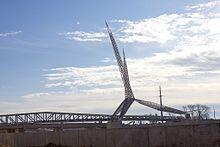
Oklahoma City is an integral point on the United States Interstate Network, with three major interstate highways ae Interstate 35, Interstate 40, and Interstate 44 ae bisecting the city. Interstate 240 connects Interstate 40 and Interstate 44 in South Oklahoma City while Interstate 235 spurs from Interstate 44 in Northcentral Oklahoma City into downtown Oklahoma City. Major state highways through the city include the Lake Hefner Parkway (SH-74), the Kilpatrick Turnpike, Airport Road (SH-152), and Broadway Extension (US-77). Lake Hefner Parkway runs through Northwest Oklahoma City while Airport Road runs through Southwest Oklahoma City and leads to Will Rogers World Airport. The Kilpatrick Turnpike loops around North and West Oklahoma City and Broadway Extension connects Central Oklahoma City to Edmond.
Oklahoma City is served by two primary airports, Will Rogers World Airport and the much smaller Wiley Post Airport (incidentally, the two honorees died in the same plane crash in Alaska) Will Rogers World Airport is the state's busiest passenger airport, with over 3 million passengers annually. Tinker Air Force Base, in East Oklahoma City, is the largest military air depot in the nation, a major maintenance and deployment facility for the Navy and the Air Force, and the second largest military institution in the state (after Fort Sill in Lawton).
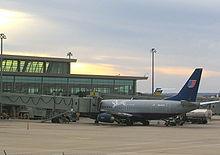
Amtrak has a train station downtown, with daily service to Fort Worth and the nation's rail network via the Heartland Flyer. Oklahoma City once was the crossroads of several interstate passenger railroads, but service at that level has long since been discontinued. Greyhound and several other intercity bus companies serve Oklahoma City at Union Bus Station, Downtown. METRO Transit is the public transit company, but is limited in its coverage of the city's main street grid. Due to the small number of bus routes offered, it operates a hub-and-spoke system that makes many journeys impractical. The bus terminal is located downtown at NW 5th Street and Hudson Avenue. A plan to improve the system is known as the Fixed Guideway Study.
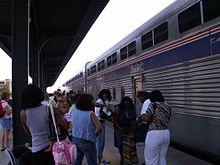
Though Oklahoma City currently has no light rail or commuter rail service, there is growing interest in incorporating light rail and commuter rail into the city's future transportation planning. In December 2009, voters in Oklahoma City passed the $777 million MAPS 3 initiative, which will include funding for an estimated 5-mile (8.0 km) to 6-mile (9.7 km) modern streetcar in downtown Oklahoma City and commuter rail (the commuter rail component would be pending subject to federal and state funding). There is also a significant push for a commuter rail line connecting downtown with the eastern suburbs of Del City, Midwest City, and Tinker Air Force Base. A short heritage rail line that will run from Bricktown to the Adventure District in Northeast Oklahoma City is under reconstruction.
A 2011 study by Walk Score ranked Oklahoma City 48th most walkable of fifty largest U.S. cities.
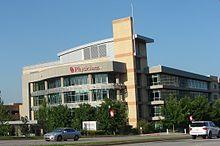
Oklahoma City and the surrounding metropolitan area are home to a number of health care facilities and specialty hospitals. OU Medicine, an academic medical institution located on the campus of The University of Oklahoma Health Sciences Center, is home to OU Medical Center, The Trauma One Center, the state's only level 1 trauma center, The Children's Hospital at OU Medical Center, OU Physicians and OU Children's Physicians, the OU College of Medicine, and the Oklahoma Cancer Center. ]
OU Medical Center Edmond, located in the northern suburb of Edmond is also part of the OU Medicine family.
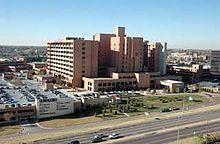
INTEGRIS Health owns several hospitals, including INTEGRIS Baptist Medical Center, the INTEGRIS Cancer Institute of Oklahoma, and the INTEGRIS Southwest Medical Center. INTEGRIS Health operates hospitals, rehabilitation centers, physician clinics, world-class doctors, mental health facilities, independent living centers and home health agencies located throughout much of Oklahoma. INTEGRIS Baptist Medical Center was named in the 2012 U.S. News & World Report's list of Best Hospitals. INTEGRIS Baptist Medical Center ranks high-performing in the following categories: Cardiology and Heart Surgery; Diabetes and Endocrinology; Ear, Nose and Throat; Gastroenterology; Geriatrics; Nephrology; Orthopedics; Pulmonology and Urology.
The Midwest Regional Medical Center located in the city's Midwest City suburb, the downtown St. Anthony's Medical Center, Oklahoma Heart Hospital and the Mercy Health Center are other hospitals. There are 347 physicians for every 100,000 people in the city.
In the American College of Sports Medicine's annual ranking of the United States' 50 most populous metropolitan areas on the basis of community health, Oklahoma City took last place in 2010, falling 5 places from its 2009 rank of 45. The ACSM's report, published as part of its American Fitness Index program, cited, among other things, the poor diet of residents, low levels of physical fitness, higher incidences of obesity, diabetes, and cardiovascular disease than the national average, low access to recreational facilities like swimming pools and baseball diamonds, the paucity of parks and low investment by the city in their development, the high percentage of households below the poverty level, and the lack of state-mandated physical education curriculum as contributing factors.
Oklahoma City has seven sister cities, as designated by Sister Cities International:

Word Count: 7878






